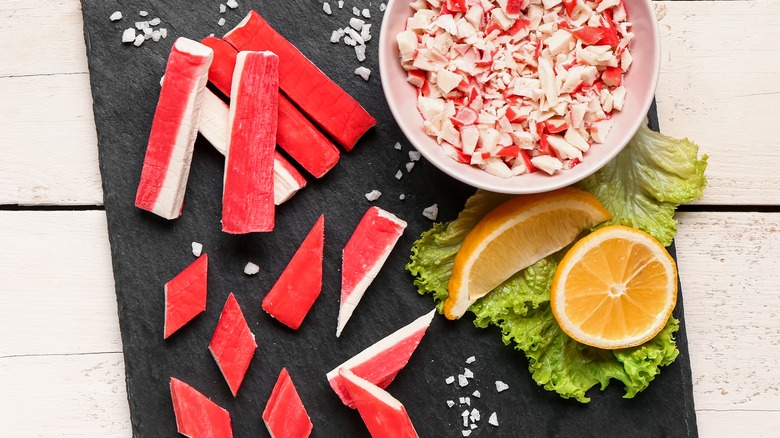Bring Even More Seafood Power To Tuna Salad With Some Imitation Crab
If tuna salad isn't quite as sea-forward as your palette desires, hold off on eschewing the beloved sandwich filling just yet. There's an alternative to mixing up the standard canned tuna, mayo, celery, and chopped onions –– but you must keep an open mind. That's because the transformative ingredient carries the word "imitation" in its name. That would be imitation crab, an easy mix-in to any tuna salad that brings extra punchy seafood power to your plate.
The misconception about imitation crab is that it's not real seafood and never swam in briny oceans, or even muddy rivers or freshwater lakes. But, that's not exactly the truth. Though imitation crab is indeed not a crustacean, like real crabs, it's still genuine seafood. Specifically, it's minced fish flesh with no bones or fat, which gets formed into a paste called surimi. The base for surimi is often pollock, a pleasant-tasting white fish with a mild flavor, which is then shaped into forms vaguely resembling crab legs. The crab-like flavor typically comes from injecting a small amount of real crab extract into the paste.
Because the taste of imitation crab is milder than the real deal, it blends effortlessly into tuna salad without bumping the namesake ingredient off the throne. Remember, the imitation crab is just a complement, not the sandwich star. But it does a fine job of taking the sea-swarthy flavor up a notch, especially when prepping it in a way that maximizes the impact.
Combining tuna and imitation crab
To keep imitation crab from standing out rather than blending into a tuna sandwich, it must have a similar structure to what's already in the mix. Imitation crab typically comes in sticks, so it won't work to simply chop it into chunks and mix it with the tuna, mayo, and other ingredients. For a seamless blend, gently shred it into flaky bits similar to what you find in canned tuna. Imitation crab is pre-cooked like tuna, so it's good to go.
Known as kanikama in Japan, imitation crab is intended to be flexible, considering the many ways it's used. Whether realizing it or not, you've likely had it in crab cakes, sushi rolls, California rolls, crab rangoon, and anything where the nature of the dish allows a crab-like flavor without noticing the absence of genuine crab texture. In that regard, tuna salad is exactly the right type of vessel; all the ingredients get mashed and mixed together for the sandwich filling of childhood memories and grownup nostalgia.
All that aside, imitation crab, sometimes referred to as crab sticks or krab, powers up the seafood flavor in tuna salad in a palette-pleasing way. It's less pricey than adding real fresh crab, though the tradeoff, according to Healthline, is more starch, less protein, and fewer nutrients. Get creative with the possibilities by adding compatible seafood seasonings such as dill, cilantro, Old Bay, lemon pepper, tarragon, basil, and parsley. Almost anything goes when it comes to tuna salad.

